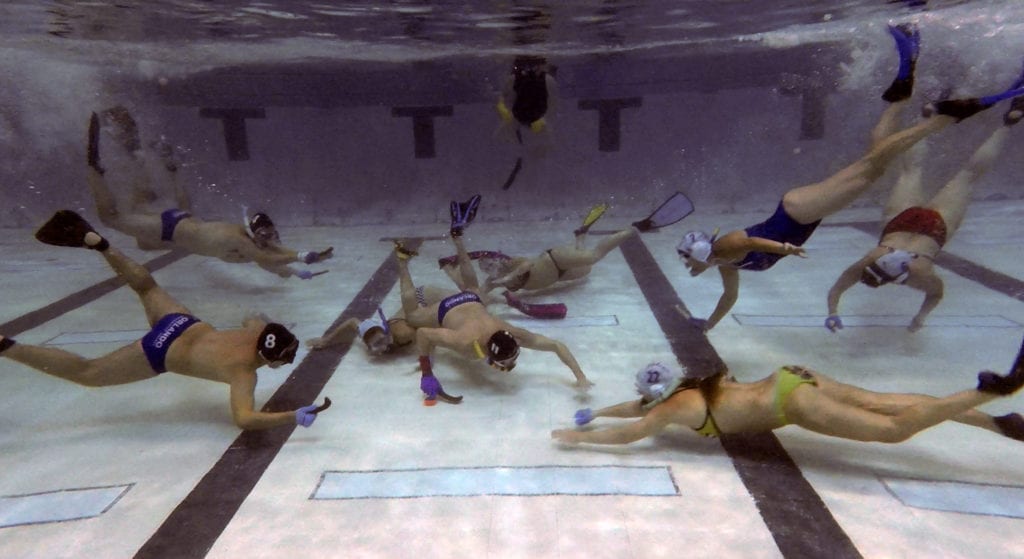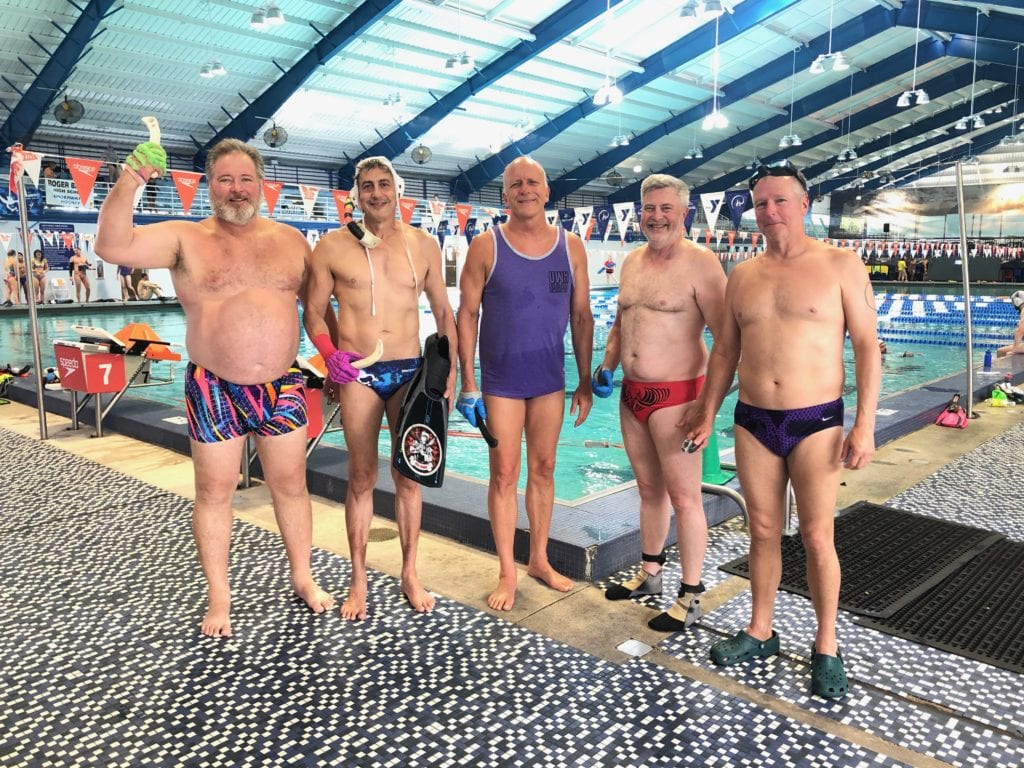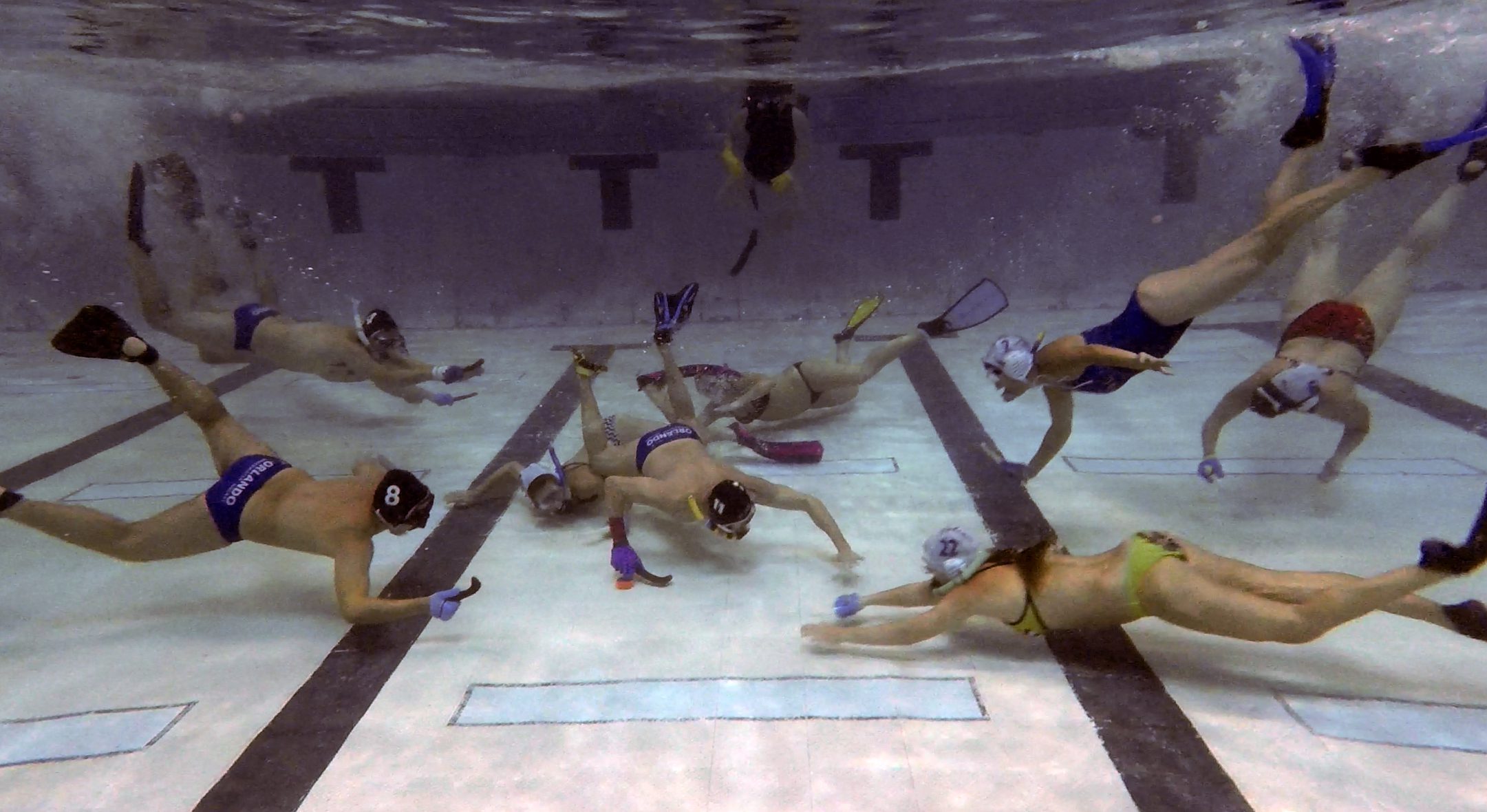Underwater hockey (no, that’s not a typo) is a real sport. Underwater hockey is one of the few team sports that 60 somethings can clash in battle alongside college players without being labeled as old kooks. Invented in the 1950s in England, it is recognized by the International Olympic Committee as a sport, although not offered yet at the Olympic Games. Even though more popular in Europe and other countries, the USA still fields 60 club teams, and there are regional, national, and world championships.
Many folks imagine full suited ice hockey players struggling in knee-deep water of a melted hockey rink when first hearing about underwater hockey. In reality, about the only commonality that ice hockey and underwater hockey share is a puck.
Underwater hockey is played co-ed in a pool 7 to 10 feet deep. Players wear a mask, snorkel, and fins and have a silicone padded glove which holds a 12-inch stick that looks a bit like an elongated comma with a handle. The puck is about the same size as an ice hockey puck but is nine times heavier weighing in at a solid 3 pounds.
Six active players and four subs on each side try to push or “flick” (shooting the puck off the bottom) the puck into the opponents’ nine-foot goal at the end of the pool. Each point is started with a “strike” or race for the puck in the center of the pool. The puck may not be moved by any part of the player’s body only the stick.
There are two features of underwater hockey that are unique to team sports. The first is that it is the only sport that requires you to hold your breath the entire time you are in the field of play. Secondly, underwater hockey is the only three-dimensional team sport. You can play above below or beside other players.
It would appear such an intense sport as underwater hockey would not be attractive to seniors. Playing alongside teammates one-third your age also sounds crazy. However, it is also the uniqueness of the sport which allows seniors to play into their seventh decade. The competition is a limited-contact sport meaning that you can’t push or shove other players, and it is a sport without gravity in a sense.

One of the biggest problems with land team sports is that players, both young and old, can’t take the ground-versus-joint stresses. In underwater hockey, you are essentially weightless. There is no blowing out knees, twisting ankles, breaking bones, etc. Size and muscle differences are less of an advantage, because you are not allowed to push or grab other players. In the sport, the women play right alongside the men.
Since only a rare individual grows up playing the sport, everyone goes through the learning curve as an adult, and the basics of the competition can be picked up in the first practice. After that, it’s all about developing skills, breath control, and stamina. Although younger players may have an advantage in the stamina arena, active, subbing seniors counter this by subbing more frequently. No matter how good a player is, they eventually have to leave the bottom and go up for air. Anyone who has a background in water sports, such as swimming, water polo, snorkeling, or scuba diving can pick up the game quickly.
The sport is a great total body workout. The games have two 15-minute continuous halves and are great for aerobic fitness and lung function.
In the 2019 Underwater Hockey USA National Championships hosted at the Rosen YMCA Aquatic Center in Orlando, Florida, nearly two dozen teams from around the country participated. This year, there were five players over the age of 60 and close to twenty players over 50.
Kendall Banks (62), who is a veteran of 39 USA UWH national championships and 13 world championships and started competing in 1977, was one of these players. However, not all players have been competing for decades. Two players, Doc Lucky Meisenheimer (61) and Michael LaHaye (61), first started playing in their mid- and late 50s. Others have crossover aquatic passions that keep them playing underwater hockey. Greg Mullersman (60) from the University of Florida plays masters water polo and has attended two world masters championships in that sport. Tim Fernan (60) aka “scuba Santa” is an avid diver and adaptive dive buddy.

All are in agreement that it is refreshing to the soul to be able to play a team sport competently with a younger generation. With Banks, Mullersman, and Meisenheimer, it has even more meaning as they play alongside their children on their respective national teams. Meisenheimer said, “I can’t tell you what a thrill it is to play alongside my son in a national championship event. In other sports, it would be an absolute anomaly, but in underwater hockey, it is not an uncommon occurrence.”
If you are interested in trying underwater hockey, check out some game videos on YouTube and look to see if there is a club near you. Don’t let your age hold you back. Underwater hockey is an extremely welcoming sport, and newbies are received with open arms at all clubs.
Editor’s note: Thanks to long-time Growing Bolder pal Dr. Lucky Meisenheimer for providing the details and photos for this story. To learn more about Doc Lucky, check out the following stories:
— Lucky’s Lake Swim
— Olympic Champ Rowdy Gaines Gets Lucky
— Lucky’s Jaws Swim
— Lucky Wins the GB Inspiration Award

